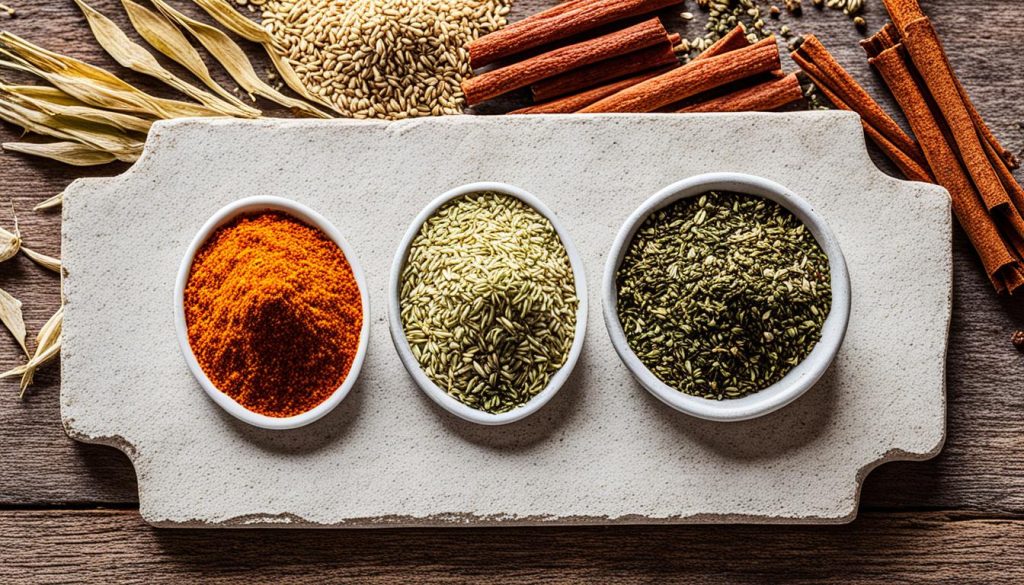Rice has been a key part of Middle Eastern and Turkish meals for ages. In the Mediterranean, wheat was the main grain. However, rice became popular in Turkey, influenced by Persian cuisine. The Ottomans brought rice pilaf, known as şehriyeli pilav, to their palace tables.
They flavored it with spices, dried fruits, and nuts. This dish has since spread throughout Turkey and the Levant. Now, it’s commonly cooked in homes and restaurants, not just palaces.
Key Takeaways
- Rice has been an integral part of Middle Eastern and Turkish cuisines for thousands of years.
- The Ottomans were instrumental in popularizing rice pilaf, or şehriyeli pilav, in their palace kitchens.
- Turkish rice is treasured for its fluffy texture, aromatic flavors, and unique addition of toasted pasta pieces called şehriye.
- Authentic Turkish rice preparation involves a traditional cooking method that requires patience and precision.
- Flavorful broths or well-seasoned water, along with the right balance of fats, are key to enhancing the flavors of Turkish rice dishes.
The Essence of Turkish Rice
Rice has been a staple in the diets of Middle Eastern and Turkish people for many years. It’s interesting to note that while wheat was the top grain, rice became popular in Turkey and the area because of Persian influences. The Ottomans greatly enhanced the use of rice pilaf, or şehriyeli pilav. They made this dish in their lavish palaces, adding special touches like spices, fruit, and nuts. This special dish has moved beyond palace dining to be a favorite in homes and restaurants across Turkey and the Levant.
An Ancient Grain with a Rich History
For thousands of years, rice has played a key role in Middle Eastern and Turkish cuisines. Even though wheat was commonly used, rice was embraced in Turkey and its neighbors thanks to the influence of Persian food culture. The Ottomans then took this rice pilaf, or şehriyeli pilav, to another level. They included it in the menus of their grand palaces, flavoring it with spices, dried fruits, and nuts.
From Ottoman Palaces to Modern Kitchens
The journey of rice pilaf from the Ottoman palaces to every-day meals is remarkable. Today, Turkish rice, or şehriyeli pilav, is known for its full taste and the crunch of toasted pasta, called şehriye. This cultural dish maintains its importance, with traditional cooking ways and flavoring methods still used. These traditions have made their way from ancient palace kitchens to the kitchens of today’s Turkey, both at home and in restaurants.
The Key Ingredients
Turkish rice dishes stand out because of the rice type, şehriye, and Baldo Pirinç. They use short-grain rice like Baldo Pirinç for its sticky texture. This is different from long-grain rice, which is thought to be better for some rice dishes.
Short-Grain vs. Long-Grain Rice
Short-grain rice is special in Turkish cooking. It’s fluffy and doesn’t stick together when cooked right. Its starch makes it tender. It fits well with other dish ingredients.
Şehriye: The Golden Pasta Pieces
Browned şehriye gives Turkish rice a special look and feel. It’s small pasta pieces sautéed in butter or oil. Adding it makes Turkish rice unlike any other.
Baldo Pirinç: The Preferred Rice Variety
Baldo Pirinç is loved for its fluffy, separate grains. This medium short-grain rice is key in Turkish kitchens. It is known for making the best Turkish cuisine, rice dishes, and pilaf recipes.

The Traditional Turkish Rice Cooking Method
To make the well-loved şehriyeli pilav, a traditional Turkish rice entree, preparation is key. It involves some patiently-followed steps. Many begin by rinsing and soaking the rice. They do this to get rid of extra starch, making the rice less sticky. This step is important but not a must-do for all.
Rinsing and Soaking the Rice
Rinsing the rice is a step that makes a big difference. It clears off any dirt and excess starch that can make the rice stick together. Although not every cook does it, some believe a quick soak in cold water for 10-15 minutes is also beneficial. It can improve the texture and keep the grains separate.
The Importance of Precise Measurements
Getting the rice and liquid amount just right is vital in Turkish cuisine. If you add too much or too little water, you’ll end up with sticky or dry rice. The ideal mix is usually 1 cup of short-grain Baldo Pirinç rice to 1 1/2 cups of liquid like broth or stock. You can also use seasoned water.
Bringing the Rice to a Boil and Resting
Once rice and liquid are mixed, you bring them to a boil. After that, the heat is turned down, and the rice is left to simmer. It should stay this way until the liquid is all gone, roughly 15-20 minutes. Then, you let the rice sit, covered, for another 20-30 minutes. This resting time is crucial. It makes the grains light and fluffy, just like the traditional Ottoman culinary tradition likes it.
Enhancing Flavors
Turkish rice dishes are made tastier by using rich broths or stocks. Home cooks might use chicken or vegetable broth for added flavor. Yet, many in Turkey just use water seasoned well with salt. Fats, like butter or olive oil, are key in making Turkish rice flavorful.
Using Broth or Water
The choice between broth and water for Turkish rice is yours. Broth, especially from chicken or vegetables, makes the dish tastier. It blends well with the rice’s spices. But, some traditional Turkish cooks stick with salted water. This lets the rice’s natural taste stand out.
The Role of Fats: Butter or Oil
Fats are important for the taste and feel of Turkish rice. Butter is used to brown şehriye, giving it a toasty flavor. A bit of butter at the end makes the rice creamy. Some also use a mix of butter and olive oil for the best balance.


